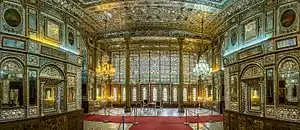Tourism in Iran
There are 8-9 million tourists from abroad visiting Iran as of 2019. Tourism in Iran is diverse, providing a range of activities from hiking and skiing in the Alborz and Zagros mountains, to beach holidays by the Persian Gulf and the Caspian Sea. The Iranian government has made concerted efforts to attract tourists to the various destinations in the country and arrivals have increased in recent years.



.jpg.webp)
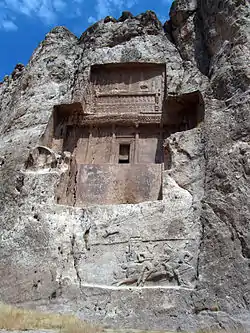


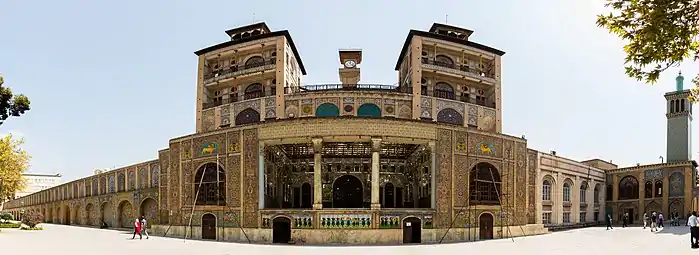
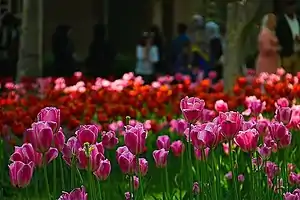
Background
Kish Island alone attracted around 1 million visitors in 2012-3, the majority of whom were Iranian, but the area also attracts many non-Iranian Muslims who like to have beach holidays with Islamic style beaches where men and women use separate beaches.[1][2]
Before the Iranian revolution in 1979, tourism was characterized by significant numbers of visitors traveling to Iran for its diverse attractions, including cultural splendours and a diverse and beautiful landscape suitable for a range of activities.[1]
Since the revolution, the majority of foreign visitors to Iran have been religious pilgrims and business people. In Iran there are many Shi'ite Shrines, the two main ones being Imam Reza Shrine in Mashhad and Fatimah al-Ma'sūmah Shrine in Qom. Each year millions of pilgrims from Iran and other Shi'ite countries visit these holy places.[1][3] Official figures do not distinguish between those traveling to Iran for business and those coming for pleasure, and they also include many diaspora Iranians returning to visit their families in Iran or making pilgrimages to holy Shia sites near Mashhad, Qom and elsewhere.[1]
Tourism declined dramatically during the Iran–Iraq War in the 1980s.
Domestic tourism in Iran was one of the largest in the world as of 2010.[4]
In 2013, the number of foreign tourists in Iran reached 4.76 million, contributing more than US$2 billion to the national economy.[3][5] The strong devaluation of the Iranian Rial since early 2012 has been a positive element for tourism in Iran. Over five million tourists visited Iran in the fiscal year of 2014-2015, four percent more year-on-year.[6] According to a report published by World Travel and Tourism Council in 2015, the size of its tourism industry was estimated as having the potential to create jobs for 1,285,500 and rise by 4.1% pa to 1,913,000 jobs in 2025. Based on the report in the year of 2014, travel and tourism directly supported 413,000 jobs (1.8% of total employment). This was expected to rise by 4.4% in 2015 and rise by 4.3% pa to 656,000 jobs (2.2% of total employment) by 2025.[7]
In October 2018, Ali Asghar Moonesan, the head of Iran's Cultural Heritage, Handicrafts and Tourism Organization (ICHTO), announced that the number of tourists who visited Iran in the first six months of the Iranian year (starting March 21) rose by 51 percent compared to the same period in 2017.[8]
Foreign visitors

The 2008 figures from the World Tourism Organization for the origin of visitors to Iran show that building up visitors from the Islamic and wider Asian world would have to start from a low base. Around three-quarters of those entering Iran in 1999 came from Europe.[1] According to the New York Times, unlike most Americans who stopped visiting Iran after the Revolution, European tourists continued to visit the country in similar numbers after the Revolution. This was mainly because the Revolution was Anti-American in nature but not so much Anti-European.[10]
Citizens of the US, United Kingdom, and Canada citizens must by law have a tour guide with them at all times.
The majority of the 3 million tourist visas granted in 2003 were obtained by Asian Muslims, who may have intended to visit important pilgrimage sites in Mashhad and Qom.
Several organized tours from Germany, France, the UK and other European countries come to Iran annually to visit archaeological sites and monuments. Iran had 21 places on the world cultural heritage list as of August 2017,[11] attracting many cultural tourists.
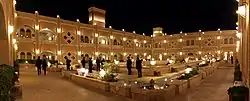
According to official statistics, about 1,659,000 foreign tourists visited Iran in 2004 - although government statistics don't distinguish between tourism, business and religious pilgrims; most came from Asian countries, including the republics of Central Asia, while a small share (about 10%) came from North America and the European Union, including Germany, Italy, Bulgaria, France and Belgium. The most popular tourist destinations were Mazandaran Province, Yazd, Isfahan,[13] Mashhad, Gilan Province and Fars Province. There is undoubtedly great scope for increased visitors from the Islamic world, and possibly also from non-Muslim countries with which Iran is developing business and political links, such as China and India.[1]
From 2004, the country experienced a 100 percent growth in foreign tourist arrivals until mid-2008, when the number of foreign arrivals surged up to 2.5 million. In particular, there was an enormous increase in the number of German tourists traveling to Iran.[14]
The World Travel and Tourism Council claims that business and personal tourism rose by 11.3% and 4.6%, respectively, in real terms in 2007, with the growth in personal tourism only modestly below that of the preceding year.[1]
In 2011, most of Iran's international visitors arrived in Iran solely for the purpose of leisure travel. Leisure tourists arriving from abroad are also often relatives of Iranian citizens or expatriates residing outside of Iran returning to visit. Another key segment of international arrival traffic are pilgrims come to pay a visit to one of the many holy sites scattered throughout the country.[15]
The number of international arrivals has been steadily increasing, up from 2.2 million people in 2009 to 3.6 million in 2011, with per capita spending of $1,850 per visit on average.[15][16]
Over five million tourists visited Iran in the fiscal year of 2014-2015, ending March 21, four percent more year-on-year.[6]

| (Source: EIU)[1] | 2004 | 2005 | 2006 est. |
|---|---|---|---|
| International tourism, arrivals ('000) | 1,656 | 1,720 | 1,769 |
| International tourism, receipts (US$ m) | 917 | 971 | 1,022 |
Visa requirement
Iran has tried to improve its complex and time-consuming visa application process and started to issue week-long visas for the nationals of 68 countries at airports.[17] Visas can now be secured electronically and be collected from Iranian consulates or international airports.[18]
Iran has road border crossings connecting it with Iraq, Turkey, Afghanistan, Pakistan, Turkmenistan, Armenia and Azerbaijan. Rail lines from Turkey and Turkmenistan can also be used to enter Iran. About 70% of visitors arrived by land in 2002, about 29% by air and less than 1% by sea. In April 2005 the Imam Khomeini International Airport was reopened under the management of a consortium of four local airlines—Mahan Air, Aseman, Caspian Air and Kish Air—although no formal contract appeared to have been awarded.[1]
Infrastructure and the economy
In the early 2000s the industry still faced serious limitations in infrastructure, communications, regulatory norms, and personnel training.[20] In late 2003 there were about 640 hotels in Iran and around 63,000 beds.[1]
In FY 2003 Iran had about 69,000 restaurants and 6,000 hotels and other lodging places; about 80 percent of these establishments were in urban areas. Some 875 restaurants and hotels were publicly managed by cooperatives and government organizations. More than 95 percent of restaurants and hotels had fewer than five employees, and only 38 had more than 100 employees. In FY 2002 this sector employed more than 166,000 people, 42,000 of whom worked in places of lodging. Of the 56,618 beds in all hotels, about half were located in three- to five-star hotels.[21]
In recent years, 235 hotels, hotel apartments, motels and guesthouses have become operational nationwide. As at 2010, 400 hotels and 200 hotel apartments are under construction nationwide. Some 66 percent of these projects are underway in the provinces of Tehran, Gilan, Mazandaran, Razavi Khorasan and Isfahan.[22]
Cultural Heritage, Handicrafts and Tourism Organization of Iran
Reason for domestic travel and overnight stay[15]
Iran's Cultural Heritage, Tourism and Handicrafts Organization is responsible for the establishment, development and operation of tourism facilities in Iran, planning for the repair or extension of tourism facilities through direct investment or providing loans to the private sector or entering into partnership with the private sector, issuing licenses and supervising the establishment and administration of hotels and restaurants and travel agencies and qualification and rating of these units.[23]
Area considered for further expansion in the tourism sector in Iran are eco tourism, coastlines, restoration of historical relics, handicraft townships, and health tourism (e.g. water therapy).[4][22] 30,000 people come to Iran each year to receive medical treatment (2012).[24] As a matter of fact, Iran might become the leading country in the Islamic World when it comes to the medical tourism field due to a number of reasons that include the country's unique geographical position, the fluctuation of Iranian currency that leads to lower prices in healthcare services, as well as the development in medical research and technology. The rapid growth rate of the healthcare system which, according to the World Tourism Organization, has increased of 5% in last decade, seems to indicate that in the future Iran will be one of the most visited countries by medical tourists, above all coming from the neighbouring countries, such as Azerbaijan, Iraq and Persian Gulf States.[25]
Officials state that Iran has in recent years earned about US$1bn a year from tourism.[1] Close to 1.8% of national employment is generated in the tourism sector.[15] Weak advertising, unstable regional conditions, a poor public image in some parts of the world, and absence of efficient planning schemes in the tourism sector have all hindered the growth of tourism.[1]
Iran's '20-Year Vision' document projects investment of over $32 billion in the country's tourism sector and targets 20 million tourists by 2025.[26][27] In order to encourage domestic and foreign direct investment in this sector, the 50 percent tax exemption previously granted to tourism enterprises has been extended to include five-star hotels.[28] In 2016 Iran announced that it will grant 100 percent tax holidays between five and 13 years depending on the region for hoteliers investing in Iran.[29] Tariffs for utilities comply with industrial ones.[22] Investment in Iran's free trade zones are exempt from taxes for up to 20 years.[22] As of 2016, international hotel operators investing in Iran are Rotana (Abu Dhabi), Accor (France), Meliá (Spain) and Steigenberger (Germany) among others.[30][31]
Outward tourism
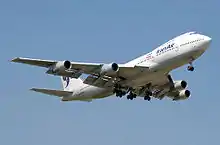
| (Source: EIU)[1] | 2004 | 2005 | 2006 est. |
|---|---|---|---|
| International tourism, departures ('000) | 3,478 | 3,648 | 3,986 |
| International tourism, expenditure (US$ m) | 4,353 | 1,380 | 1,579 |
Traditionally, only a small number of wealthy Iranian tourists traveled abroad, and the majority of the trips were business departures, mostly to neighboring states in the Persian Gulf and the wider Middle East (1 million each year), Central Asia and Turkey (~1 million). Although this is likely to continue to characterize much Iranian travel abroad, since the change of regime in Iraq in 2003, Iranians from all walks of life have visited their western neighbor. In addition, a large proportion of Iranians traveling abroad are likely to be visiting family, especially in Europe, the US and Australia (~1 million).[1] Up until early 2012, because the Iranian rial was overvalued, the Iranian government was subsidizing its travelers abroad (2010). In 2011, some 27 million travelers and businessmen passed the Iranian custom departments.[32] Following the Iranian subsidy reform plan, airfares in Iran went up by 65% in 2012.[33] In 2012, Iranians spent $18.5 billion on outward tourism.[34] They spent $12 billion to purchase airplane tickets from foreign airliners between the years 2012-2015.[35]
See also
- Iranian people
- History of Iran
- Culture of Iran
- Iranian art
- Demography of Iran
- Geography of Iran
- Tehran
- Tabriz
- Mazandaran
- Kermanshah
- Shiraz
- Sanandaj
- Isfahan
- Yazd
- Kish Island
- Airlines of Iran
- Homa Hotel Group
- List of museums in Iran
- Persepolis
- Sport in Iran
- Iranian cuisine
- International rankings of Iran
- United Nations World Tourism Organization
- Visitor attractions in Iran
- Naqsh-e Jahan Square
References
- "Iran Travel And Tourism Forecast", Economist Intelligence Unit, August 18, 2008
- "Iran seeks more tourists, but will they come?". Washington Post. Archived from the original on 13 December 2015. Retrieved 9 June 2015.
- Jason Rezaian (5 November 2012). "Iran's surprise economic success: Tourism". Washington Post. Archived from the original on 13 July 2015. Retrieved 9 June 2015.
- "Press TV". Press TV. 2010-12-06. Archived from the original on 2012-01-18. Retrieved 2012-02-06.
- Laura Bly, USA TODAY (25 February 2013). "Tourists see a different Iran reality than 'Argo' image". USA TODAY. Archived from the original on 28 August 2015. Retrieved 9 June 2015.
- "Nearly one million Azerbaijani tourists visit Iran annually". AzerNews.az. 13 November 2015. Archived from the original on 23 April 2019. Retrieved 2 May 2019.
- "Iran Tourism Need to Rebuild its Image After the Nuclear Deal". SURFIRAN. Archived from the original on 2016-04-15. Retrieved 2016-04-21.
- "Number of Tourists Visiting Iran Increases by 50%". 2018-10-04. Archived from the original on 2018-10-05. Retrieved 2018-10-07.
- "Traveling to Iran with Jacki & Kach (Episode 1: Shiraz)".
- Glusac, Elaine (2016-02-08). "Sanctions Lifted, American Tourists Head to Iran". The New York Times. Archived from the original on 2017-08-12. Retrieved 2017-03-03.
- Centre, UNESCO World Heritage. "Iran (Islamic Republic of) - UNESCO World Heritage Centre". whc.unesco.org. Archived from the original on 2017-08-16. Retrieved 2017-08-15.
- "American tourists in Iran (Episode 3: Yazd)".
- "Traveling to Iran with Jacki & Kach (Episode 2: Isfahan)".
- "Herald Globe". Story.heraldglobe.com. 2008-11-15. Archived from the original on 2012-02-18. Retrieved 2012-02-06.
- Ayse, Valentine; Nash, Jason John; Leland, Rice (January 2013). The Business Year 2013: Iran. London, U.K.: The Business Year. p. 166. ISBN 978-1-908180-11-7. Archived from the original on 2016-12-27. Retrieved 2014-03-16.
- "Archived copy" (PDF). Archived (PDF) from the original on 2014-07-14. Retrieved 2014-07-12.CS1 maint: archived copy as title (link)
- Iran-daily Archived January 23, 2009, at the Wayback Machine
- "Iran Visa Application - Iranian Visa (evisa)". Archived from the original on 27 May 2015. Retrieved 9 June 2015.
- "American travelers exploring Tehran".
- COUNTRY PROFILE: IRAN Archived 2005-02-26 at the Wayback Machine Retrieved 12 February 2008
- http://lcweb2.loc.gov/frd/cs/pdf/CS_Iran.pdf Archived 2015-06-22 at the Wayback Machine
 This article incorporates text from this source, which is in the public domain.
This article incorporates text from this source, which is in the public domain. - "No. 3816 | Front page | Page 1". Irandaily. 2010-11-02. Archived from the original on 2012-04-01. Retrieved 2012-02-06.
- Butler, Richard; O'Gorman, Kevin D.; Prentice, Richard (2012-07-01). "Destination Appraisal for European Cultural Tourism to Iran". International Journal of Tourism Research. 14 (4): 323–338. doi:10.1002/jtr.862. ISSN 1522-1970.
- "Fars News Agency :: Ahmadinejad Stresses Iran's Growing Medical Tourism Industry". English.farsnews.com. 2012-01-17. Archived from the original on 2012-02-13. Retrieved 2012-02-06.
- "Medical Tourism in Iran - Fanack Chronicle". Fanack Chronicle. Archived from the original on 2 April 2015. Retrieved 9 June 2015.
- "No Operation". Presstv.ir. Archived from the original on 2012-09-15. Retrieved 2012-02-06.
- Tehran Times: Iran’s foreign tourist arrivals continue to increase Archived 2012-11-09 at the Wayback Machine Retrieved February 16, 2012
- "Doing business in Iran - For Australian exporters". Austrade. Archived from the original on 2012-02-02. Retrieved 2012-02-06.
- "PressTV-Iran offers 13-year tax break to hoteliers". www.presstv.com. Archived from the original on 2019-05-02. Retrieved 2019-05-02.
- The Economist (16 December 2015). "Why tourism is developing in Iran - The Economist". Archived from the original on 27 September 2016. Retrieved 23 October 2016 – via YouTube.
- Peter Grant (October 4, 2016). "Developers Make Bets on Iran". Wall Street Journal.
- "Irandaily | No. 4207 | Domestic Economy | Page 4". Archived from the original on 2012-04-14. Retrieved 2012-04-15.
- "Iranian airfares soar higher". Archived from the original on 17 April 2015. Retrieved 9 June 2015.
- Asa Fitch and Nicolas Parasie (6 April 2015). "Western Companies See Potential in Reaching Iran's Consumers After Nuclear Deal". WSJ. Archived from the original on 14 January 2016. Retrieved 9 June 2015.
- "Iran Air stock to be sold globally". 2016-02-24. Archived from the original on 2017-10-27. Retrieved 2016-02-25.
Further reading
- A Glimpse of Iran (first encyclopedic English book on tourism in Iran) by Iran's Cultural Heritage, Handicrafts and Tourism Organization
- Travels in the 'Real Iran' by Eric Weiner, World Hum, June 19, 2009
External links
| Wikivoyage has a travel guide for Iran. |
- IR-IRAN Electronic Visa (Iran eVisa) Application System
- Iran's official tourism website List of tourist attractions. Also helps tourists apply for entrance visas online and provides them with important phone numbers and necessary information about transportation and foreign Embassies in the country.
- Raja Rail Transport Co Official Website
- Fadak Trains Official Website
- List of airlines of Iran
- Irpedia Tourism - The official website of tourism industry association of Iran
- Iranian Students Tourism & Travel - affiliated with the Academic Center for Education, Culture, and Research
- "Daftar.org" - online visa application for U.S. citizens - Iranian Consular services in Washington D.C.
- Pictures of Iran - WorldIsRound
- Iran Photo Gallery - 782 color, high-resolution Creative Commons images of Iran from a 2012 journey.
- Iran Travel and Tourism at Curlie
- Things that visitors must know before traveling to Iran
- Videos
- Travel Guides/Iran - Expoza Travel (2016)
- Why tourism is developing in Iran - The Economist (2015)
- Tourism in Iran - PressTV (2011)
- Iranian Hospitality Industry - PressTV (2010)
- Rick Steves' Iran Lectures
- Rick Steves' Iran- PBS video documentary on Iran (2009)
- Health care and health tourism in Iran - Part I Part II Part III - PressTV

